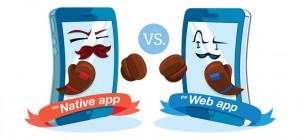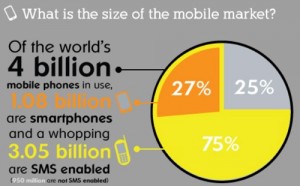Recently an article was published in the Harvard Business Review by Sunil Gupta, the Head of the Marketing Unit at Harvard Business School. Entitled, “FOR MOBILE DEVICES, THINK APPS, NOT ADS“, the article suggested that apps are how marketers will interact with consumers in the future, because of time spent in app vs. other mobile activities.
I just don’t agree with the app as a one-size-fits-all philosophy. Most apps are used an average of 1.7 times. Yes, consumers spend the bulk of their time in apps, but it’s a tiny handful of apps, around 15 on average. It’s a tough road to become one of the 15. This is really a strategy for household name brands with big development and app promotion budgets.
I believe a more mainstream mobile marketing strategy is to look at two of those apps that consumers use a lot: SMS inbox (iMessage, etc) and the browser (Chrome, Safari) It’s very cost-effective to build out a mobile opt-in list and build web apps where consumers can engage with your brand, offers and incentives in a 1:1 way. This essentially builds up from the world of opt-in email lists and web pages and brings it to mobile.

Courtesy of MeltMedia
A lot of the mindset that “consumers spend 80% of their time in apps” comes from Flurry data, which nobody seems to question. I have yet to see a detailed app-by-app breakdown from Flurry, so I wonder how much Flurry is breaking out apps like SMS messenger apps, which is used hundreds if not thousands of times a day, and the browser apps like Chrome and Safari which are used when a user clicks a link. I wonder how much they are counting email apps, where consumers now open 60% of all emails. These are apps which I instinctively belive capture a huge amount of consumer attention vs. the “now you see them, now you don’t” nature of most native apps.
To build an audience around an app requires a marketer to:
- Build the app.
- Get it right.
- Submit it to Apple/Google.
- Get it approved.
- Promote it in the app store and buy advertising.
- Get the consumer to download the app.
- Get the consumer to opt-in to receive push notifications.
- And then ultimately battle the odds to get the consumer to use the app more than 1.7 times.
Oh, and get Apple and Google’s permission and approval every time they want to update the apps. That is one expensive road.
Compare this to getting a consumer to simply opt-in to a short-code (eg “text ACE to 55155”) and be able to receive push SMS that link to mobile web pages and apps on a permission basis. Marketers can push messages and update mobile web pages whenever they like, and it’s much easier than building or updating a native app. Building this audience up will enable marketers to then extend the engagement of their audience by layering in a native app to the mix in a way that is meaningful for the consumer.
I know it’s in vogue right now to diss mobile display ads, but the fact of the matter is mobile advertising provides excellent, targeted reach in a very cost effective way. Marketers can precisely target by geo, time of day, gender, income, even pollen count. Rich media ads (adhesion pull from a display banner ad based on IAB/MMA MRAID specs) provide deep brand engagement, on very cost effective CPM and CPC prices. Marketers can use these ads to build their lists, test consumer sentiment and offer coupons and incentives. The campaigns behind these mobile ads can be folded into existing co-op budgets and integrated into existing multi-channel marketing so mobile augments and enhances existing consumer to brand touch points like print, digital, in store, email, SMS, and, yes native app push notifications.
Marketers need mobile excellence in a multi-channel world, not just an app. An app is fine and works for a lot of situations, but it’s often more an endpoint or node of a mobile strategy than a strategy unto itself.


